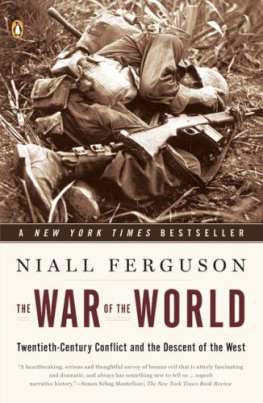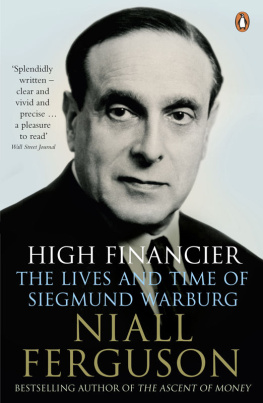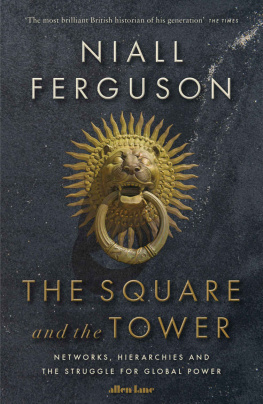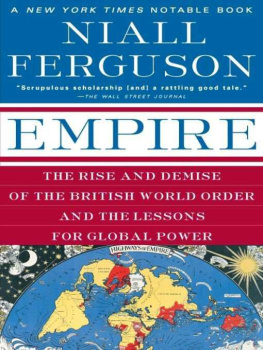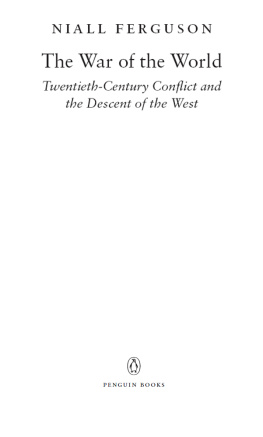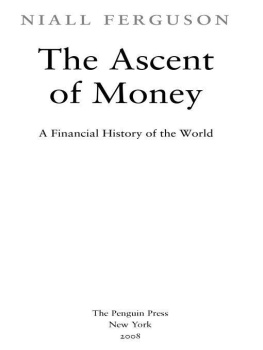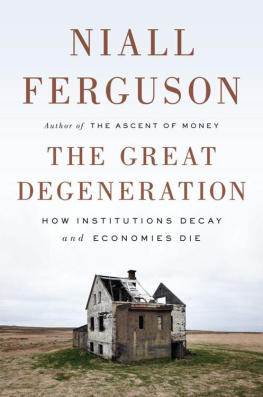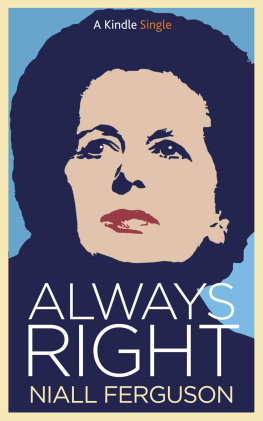
PENGUIN BOOKS
Contents
PART I
The Great Train Crash
PART II
Empire-States
PART III
Killing Space
PART IV
A Tainted Triumph
List of Illustrations
Section 1: 19001928
. Racial Map of Europe (1923).
. The Yellow Peril: drawing of 1895 by Hermann Knackfuss.
. European soldiers captured at the Battle of Yang-Cun are brought before the Boxer generals.
. Bon appetit!: German cartoon of March 1904.
. Pogrom victims and survivors, Odessa 1905.
. The Archduke Francis Ferdinand meets Bosnian dignitaries in Sarajevo, June 28, 1914.
. Gavrilo Princip and the other members of Young Bosnia in court in Sarajevo.
. Two soldiers from Frances West African colonies during the First World War.
. Scottish prisoners of war, First World War.
. Russian cartoon of the peace negotiations at Brest-Litovsk, 191718.
. An anti-Semitic caricature of Trotsky from the Russian Civil War era.
. The waterfront at Danzig (Gdask).
. The bodies of Armenian children, Turkey 1915.
. Rudolf Schlichter, Armenian Horrors, watercolour on paper c. 1920.
. Greek refugees throng the docks at Smyrna, fleeing from Turkish troops, September 1922.
Section 2: 19291942
. Georg Groszs Grosstadt (1917).
. Poverty in the American Depression.
. Look, you boob !: George Bernard Shaw on the superiority of Soviet Communism.
. Soviet industrialization poster.
. Ukrainian collectivization poster.
. Georgian poster on self-determination.
. Gulag prisoners.
. Jacob Abter, one of the members of the Leningrad Society for the Deaf and Dumb executed during the Great Terror.
. An ethnic German family takes a break from harvest toil.
. Illustration from a childrens book published by the Strmer Ver-lag in 1935.
. Victor Klemperer.
. Isaiah Berlins diplomatic pass, issued on September 15, 1945.
. Hershel and Rivka Elenberg.
. Henryka Lappo before deportation from eastern Poland to the Soviet Union.
. A Nazi wartime poster blaming atrocities on Jewish-Bolshevism.
. Five Jewish women and girls about to be shot outside Liebau, in Latvia, in December 1941.
. Victims of the Rape of Nanking.
. A man tends children wounded in a Japanese raid on Shanghai railway station, 1937.
Section 3: 19431953
. Marja and Czeslawa Krajewski, murdered in medical experiments at Auschwitz in 1943.
. The Axis powers as aliens: American wartime poster.
. Tatars in the Red Army.
. A German soldier in the wake of the Battle of Kursk in July 1943.
. Nazi poster for Dutch consumption.
. The destruction of Dresden in February 1945.
. The Seattle Post-Intelligencers caricature Mr Moto.
. Phoenix war worker Natalie Nickerson with a Japanese soldiers skull.
. Two American tanks advance under Japanese fire during the Battle for Okinawa, June 1945.
. A Japanese naval lieutenant is persuaded to lay down his arms on Okinawa.
. A Soviet soldier tries to steal a Berlin womans bike.
. Soldiers training in Guatemala to fight the Guerrilla Army of the Poor.
. Chinese children read from Chairman Maos Little Red Book.
. Pol Pot greets Deng Xiaoping in Phnom Penh in 1978.
. Milan Luki in his home town of Viegrad in 1992.
Picture Acknowledgements
Picture 1; taken from Source Records of the Great War, Vol. VII (1928)
Pictures 26, 10, 12, 14, 37, 48: AKG images, London
Pictures 7, 13, 15, 40, 43, 44, 46, 47: Hulton Archive/Getty Images
Picture 16: DACS 2006 (supplied by Bridgeman Art Library)
Picture 21: The David King Collection
Pictures 25, 30: Mary Evans Picture Library
Pictures 26, 38, 49: Empics
Picture 27: Reproduced with permission of Curtis Brown Group Ltd, London, on behalf of the Isaiah Berlin Literary Trust. Copyright Isaiah Berlin Literary Trust
Picture 28: Ty Rogers
Picture 29: Mrs H. Lappo
Picture 33: Hulton-Deutsch Collection/Corbis
Pictures 34, 35: Auschwitz-Birkenau Museum and Memorial
Picture 42: Time Life Pictures/Getty Images
Picture 45: Ullstein Bild
Every effort has been made to trace copyright holders, but this has not been possible in all cases. If notified, the publishers will be pleased to rectify any omissions at the earliest opportunity.
List of Maps
. The Jewish Pale of Settlement
. Austria-Hungary before the First World War
. The German diaspora in the 1920s
Political boundaries after the Paris peace treaties, c. 1924
. The Asian empires in autumn 1941
. Manchuria and Korea
. The Second World War in Asia and the Pacific, 194145
. The Nazi Empire at its maximum extent, autumn 1942
. The Pale of Settlement and the Holocaust
. Germany partitioned, 1945
PENGUIN BOOKS
THE WAR OF THE WORLD
Quite stunning The Times Literary Supplement
Full of epigrams, witticisms and thought-provoking paradoxes and ironies supremely readable and thought-provoking Andrew Roberts
This is Fergusons best work, by far, since The Pity of War Paul Kennedy, New York Review of Books
Delivered with immense brio and pace so easy to zip through Spectator
Entertainingly provocative He is a fine debunker Economist
A great read One is swept along by the authors superb clarity of expression and the persuasive verve of his style Irish Times
A gripping read Scotland on Sunday
A thoughtful, often provocative, portrait of the period an historian who can rattle cosy assumptions The Times
Without doubt, this is Fergusons best work to date one of the most revolutionary reinterpretations of this era Tribune
A sweeping and handsomely controlled narrative in which he balances wide-screen storytelling and close-focus anecdote Even those who have read widely in twentieth-century history will find fresh, surprising details Boston Globe
Again he shows himself to be a writer of extraordinary energy and versatility Norman Stone, Wall Street Journal
Wielding at once the encyclopedic knowledge of an accomplished scholar and the engaging prose of a master storyteller, Ferguson commendably brings fresh insights to a history by now familiar San Francisco Chronicle
A staggering achievement. Written in clear, lively prose, it asks to be savoured, enjoyed and argued with Sunday Morning Post (South China)
ABOUT THE AUTHOR
Niall Ferguson is one of Britains most renowned historians. He is Laurence A. Tisch Professor of History at Harvard University, a Senior Research Fellow of Jesus College, Oxford University, and a Senior Fellow of the Hoover Institution, Stanford University. The bestselling author of Paper and Iron, The House of Rothschild, The Pity of War, The Cash Nexus, Empire and Colossus, he also writes regularly for newspapers and magazines all over the world. Since 2003 he has written and presented three highly successful television documentary series for Channel Four: Empire, American Colossus and, most recently, The War of the World




